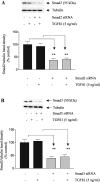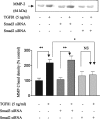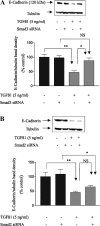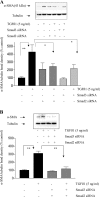The differential role of Smad2 and Smad3 in the regulation of pro-fibrotic TGFbeta1 responses in human proximal-tubule epithelial cells
- PMID: 16253118
- PMCID: PMC1360711
- DOI: 10.1042/BJ20051106
The differential role of Smad2 and Smad3 in the regulation of pro-fibrotic TGFbeta1 responses in human proximal-tubule epithelial cells
Abstract
In chronic renal diseases, progressive loss of renal function correlates with advancing tubulo-interstitial fibrosis. TGFbeta1-Smad (transforming growth factor-beta1-Sma and Mad protein) signalling plays an important role in the development of renal tubulo-interstitial fibrosis. Secretion of CTGF (connective-tissue growth factor; CCN2) by PTECs (proximal-tubule epithelial cells) and EMT (epithelial-mesenchymal transdifferentiation) of PTECs to myofibroblasts in response to TGFbeta are critical Smad-dependent events in the development of tubulo-interstitial fibrosis. In the present study we have investigated the distinct contributions of Smad2 and Smad3 to expression of CTGF, E-cadherin, alpha-SMA (alpha-smooth-muscle actin) and MMP-2 (matrix-metalloproteinase-2) in response to TGFbeta1 treatment in an in vitro culture model of HKC-8 (transformed human PTECs). RNA interference was used to achieve selective and specific knockdown of Smad2 and Smad3. Cellular E-cadherin, alpha-SMA as well as secreted CTGF and MMP-2 were assessed by Western immunoblotting. TGFbeta1 treatment induced a fibrotic phenotype with increased expression of CTGF, MMP-2 and alpha-SMA, and decreased expression of E-cadherin. TGFbeta1-induced increases in CTGF and decreases in E-cadherin expression were Smad3-dependent, whereas increases in MMP-2 expression were Smad2-dependent. Increases in alpha-SMA expression were dependent on both Smad2 and Smad3 and were abolished by combined knockdown of both Smad2 and Smad3. In conclusion, we have demonstrated distinct roles for Smad2 and Smad3 in TGFbeta1-induced CTGF expression and markers of EMT in human PTECs. This can be of therapeutic value in designing targeted anti-fibrotic therapies for tubulo-interstitial fibrosis.
Figures






Similar articles
-
TGFbeta1 induces epithelial-mesenchymal transition, but not myofibroblast transdifferentiation of human kidney tubular epithelial cells in primary culture.Int J Exp Pathol. 2006 Jun;87(3):197-208. doi: 10.1111/j.1365-2613.2006.00479.x. Int J Exp Pathol. 2006. PMID: 16709228 Free PMC article.
-
TGF-β2 induces transdifferentiation and fibrosis in human lens epithelial cells via regulating gremlin and CTGF.Biochem Biophys Res Commun. 2014 May 16;447(4):689-95. doi: 10.1016/j.bbrc.2014.04.068. Epub 2014 Apr 19. Biochem Biophys Res Commun. 2014. PMID: 24755068
-
TGF-beta1-induced connective tissue growth factor (CCN2) expression in human renal proximal tubule epithelial cells requires Ras/MEK/ERK and Smad signalling.Nephron Exp Nephrol. 2005;100(4):e156-65. doi: 10.1159/000085445. Epub 2005 Apr 25. Nephron Exp Nephrol. 2005. PMID: 15855807
-
Gene regulation of connective tissue growth factor: new targets for antifibrotic therapy?Matrix Biol. 2002 Oct;21(6):473-82. doi: 10.1016/s0945-053x(02)00055-0. Matrix Biol. 2002. PMID: 12392758 Review.
-
Connective tissue growth factor: structure-function relationships of a mosaic, multifunctional protein.Growth Factors. 2008 Apr;26(2):80-91. doi: 10.1080/08977190802025602. Growth Factors. 2008. PMID: 18428027 Review.
Cited by
-
Retinoic acid promotes myogenesis in myoblasts by antagonizing transforming growth factor-beta signaling via C/EBPβ.Skelet Muscle. 2015 Mar 18;5:8. doi: 10.1186/s13395-015-0032-z. eCollection 2015. Skelet Muscle. 2015. PMID: 25878769 Free PMC article.
-
IHG-1 amplifies TGF-beta1 signaling and is increased in renal fibrosis.J Am Soc Nephrol. 2008 Sep;19(9):1672-80. doi: 10.1681/ASN.2007101080. Epub 2008 May 28. J Am Soc Nephrol. 2008. PMID: 18508967 Free PMC article.
-
Ferulic Acid Attenuates TGF-β1-Induced Renal Cellular Fibrosis in NRK-52E Cells by Inhibiting Smad/ILK/Snail Pathway.Evid Based Complement Alternat Med. 2015;2015:619720. doi: 10.1155/2015/619720. Epub 2015 Apr 8. Evid Based Complement Alternat Med. 2015. PMID: 25949265 Free PMC article.
-
Key Fibrogenic Signaling.Curr Pathobiol Rep. 2015;3(2):183-192. doi: 10.1007/s40139-015-0077-z. Curr Pathobiol Rep. 2015. PMID: 25973345 Free PMC article. Review.
-
Profibrotic TGFβ responses require the cooperative action of PDGF and ErbB receptor tyrosine kinases.FASEB J. 2013 Nov;27(11):4444-54. doi: 10.1096/fj.12-224907. Epub 2013 Aug 2. FASEB J. 2013. PMID: 23913859 Free PMC article.
References
-
- Nath K. A. Tubulointerstitial changes as a major determinant in the progression of renal damage. Am. J. Kidney Dis. 1992;20:1–17. - PubMed
-
- Border W. A., Noble N. A. TGF-β in kidney fibrosis: a target for gene therapy. Kidney Int. 1997;51:1388–1396. - PubMed
-
- Bottinger E. P., Bitzer M. TGF-β signaling in renal disease. J. Am. Soc. Nephrol. 2002;13:2600–2610. - PubMed
-
- Okada H., Kikuta T., Kobayashi T., Inoue T., Kanno Y., Takigawa M., Sugaya T., Kopp J. B., Suzuki H., Kikuta T. Connective tissue growth factor expressed in tubular epithelium plays a pivotal role in renal fibrogenesis. J. Am. Soc. Nephrol. 2005;16:133–143. - PubMed
-
- Liu Y. Epithelial to mesenchymal transition in renal fibrogenesis: pathologic significance, molecular mechanism, and therapeutic intervention. J. Am. Soc. Nephrol. 2004;15:1–12. - PubMed
Publication types
MeSH terms
Substances
LinkOut - more resources
Full Text Sources
Other Literature Sources
Miscellaneous

